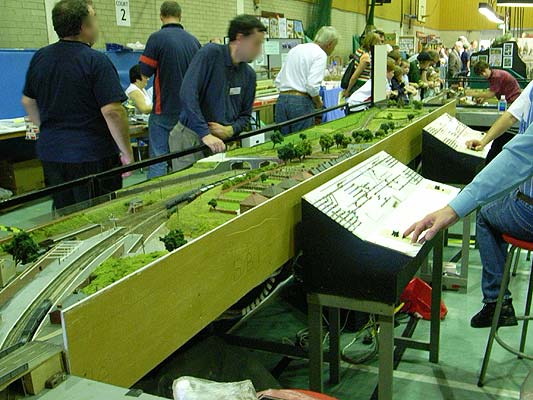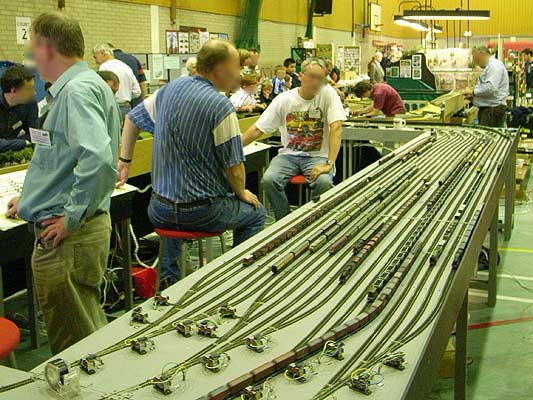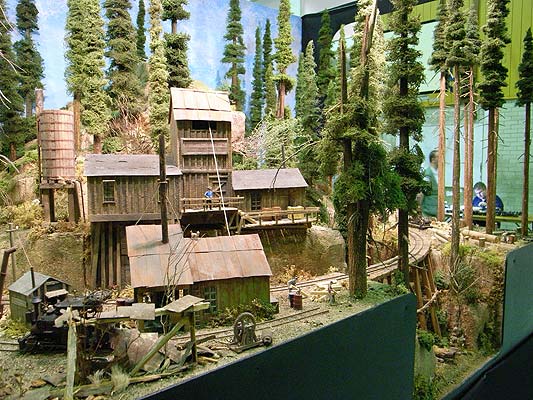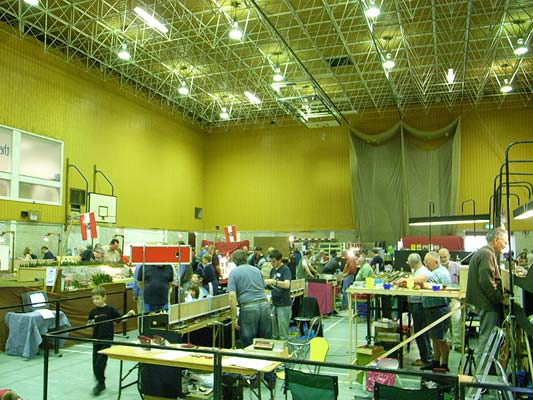Last weekend saw Jack and I take a trip to the Western Modern Railway Society‘s West Of London Model Railway Exhibition in South Ruislip. It’s been 18 years or more since I’ve been to a model railway exhibition. I wanted to see what it was like now.

First observation: Nothing has changed. The technology is the same as it was–the trains are controlled with a voltage knob wired to the track, and the points are controlled by switches directly connected. I guess I was expecting some involvement of computers, or some automation… but maybe that’s not the point. I did see two chaps operating trains on the same layout, communicating only through on-layout signals, just as regular train operators would. It’s apparently very absorbing, operating the controls.
I don’t know whether this was true when I last went to an exhibition, but the technology was surprisingly unreliable. Trains often needed assistance to get over a rough patch in the track, especially at slow speeds, and people were often doing small amounts of maintenance. The scenery, on the other hand, sometimes looked neglected (on some layouts).
…but maybe that’s to do with the two types of layout we saw. Some layouts were all about having a place to run your model trains. The scenery was incidental, and there a number of layouts had a large sidings to store all the locomotives, carriages and freight.

The second type of layout was all about the model. The adverts in the background would be in character, the trees and landscape were well decorated, and the whole layout would be accompanied by a narrative of what sort of industry was assumed to be nearby, the purpose of the particular junction, the time period, and so on.

This model of the Canadian Rockies was particularly impressive, as were the tricks the maker used to create good-looking trees and ground. The whole layout was created in 10 weeks, but the maker generally made only one layout every 3 years. I don’t know how typical that is.
I was surprised not to see any futuristic trains. There was a small layout of Croydon Tramlink and a single layout which included diesel and electric era trains, but otherwise locomotives dominated. But where was the TGV, or a maglev? Perhaps this is simply because layouts with more points are more exciting, and futuristic, high speed trains don’t work like that.
One last point: The show was half layouts and half stands, where the stands combined tool shows, magazine sellers, and individuals making and selling trees or constructed kit locomotives. It was good to see the combination of larger and smaller sellers.

In summary, it was fascinating to go an exhibition by hobbyist model-makers, especially ones who have a small industry supporting them, taking mass produced objects (houses and trains) and completing their look for their own layout. But it was disappointing to see the lack of change over the past two decades–though I don’t know how true this is, given my hazy memories and this very small sample size.
What I got most out of the visit was an idea of the various motivations of people in the community. Some like the agency of controlling the train, some like modelling, some are selling, some have train collections they’d like to see on the tracks (but no space for a layout). Without all these people gathered around the single hobby, it wouldn’t do well. But it does make me wonder what other hobbies people would gather around, and what a model railway hobby would look like using modern technology and an internet sensibility. I have a few ideas.
12 Comments and Trackbacks
1. Tom said on 6 October 2006...
Anne beat me to it, asking “what if the values these hobbyists associate with their craft include the beauty and nostalgia of keeping history alive?”
But I was also wondering whether the state of model railway reflects the state of railways as a whole in Britain – no real post-war change. But what about other countries? Do Chinese model rail enthusiasts run cute little helium-cooled maglevs? Are there miniature bullet train modellers in Japan? Do European hobbyists give each other tiny refunds if their tiny intercity trains are a tiny bit late?
Perhaps Canadian model train enthusiasts quickly build long straight tracks and spend their entire time modelling forests instead?
Perhaps I haven’t been on enough foreign trains. But then, can you ever?
2. Tim Hall said on 7 October 2006...
Actually not all model railways nowadays use traditional DC controlled by a voltage knob. An increasing number of layouts use DCC (Digital Command Control). DCC uses a fixed voltage, with digital signals sent along the tracks to a decoder chip in the locomotive which controls the locomotive.
Often the control panel will still have a knob, but that knob is sending digital signals down the wires rather than varying the voltage.
DCC is most popular amongst people modelling more recent eras. Modern trains have powerful headlights, and DCC lets you control the lighting (head and tail) independently of the movement of the train.
So with DCC you can run a train with the correct white headlights at the front, and red ones at the back, which stay on when the train stops. If the train changes direction, you can switch off the lights and switch on the corresponding ones at the other end while the train is stationary, before it moves off heading back the way it’s come. Can’t do that with conventional DC.
There are people with models of the modern scene, with colourful post-privatisation liveries, but they’re very much a minority. You can buy things like Virgin Voyagers, Turbostars and EWS Class 66s.
As for Japan, yes there are models of Bullet trains. Model railways are *huge* in Japan, and unlike the nostalgia-based British scene, the emphasis is on modern trains. Germany and Switzerland are similar, where models of contemporary trains outsell historical ones.
The only model of the Eurostar, and the best models of the French TGV are made by Kato of Japan.
3. Matt said on 7 October 2006...
Thanks Tim! The Kato models certains are good.
I saw your blog post about the Manchester Model Railway Club’s recent exhibition, and that led me to this gallery of layouts there. Those photos are absolutely incredible. There’s some really detailed modelling on display there (I especially like the pylon in the second layout shown). I’ll have to go to a larger exhibition.
Out of interest: is DCC as satisfying to use as the traditional DC control? You have a very immediate connection with the movement of the locomotives, using a voltage knob. Is that quality preserved?
4. Adrian Full said on 7 October 2006...
Having just started to use DCC I’d say it is far more satisfying than DC. With DC you “drive the track”, with DCC you “drive the train”. You call up the locomotive you want to drive and then have control of it. On a large layout (or indeed a small one, but its more than my brain can cope with!!) you can set one train going at a certain speed, and use the controller to call up another train and drive that whilst the first one carries on happily.
As Tim says having the ability to switch lights on and off is satisfying, and sound effects (certainly in model diesel locos) are just beginning to take off. I’ve not gone this far yet, but it won’t be long, I suspect! Another feature that I like, indeed the one that made me convert from DC, is the ability to use the same handheld control unit to switch points and signals. Just change the menu and select the point you wish to change, just the same as selecting which loco to drive.
And I haven’t got into the fine tuning of acceleration and braking curves of each loco to best match the characteristics of the motor in each loco, but its all possible. The system off the shelf works fine for me, but it has a whole load of extra features should I want to “play”.
Incidentally, I model diesels, but with one layout set in 1986, and the other 2 in the mid 1970s and although not steam these are certainly historical.
5. Pete said on 8 October 2006...
I think it is unfortunate that you picked this show to gauge progress in model railways. As previous correspondents have noted Digital Command Control DCC, is the order of the day now for serious model railway constructors. Not that there is anything wrong with DC, or that DC means they are not serious, I mean that if anyone is considering the hobby, or upgrading then DCC is the way to go. The possibilities are endless when it comes to integrating this wth a computer and running software like Railroad & Co to control the entire layout.
You drive the trains not the track like in real life. The major focus these days is in on-loco sound and this is becoming very common in the British outline arena. It has been out there, like DCC, in the continent and the US for some time.
At the end of the day it is the model that counts, and the realism it can portray. Whether it is a ficticious or actual location, if it is done bad, or the rolling stock doesn’t match the location or the era it wont look right. On the other hand many MR show attendees wont know the difference.
For a serious look at DCC, sound and modern image (1955-2007) get your self up to Burton next year for the DEMU (Diesel & Electric Modellers United) Showcase.
6. Mike Page-Chestney said on 8 October 2006...
Hi. Good to see the comments about DCC control as it hasreally brought my interest back to life. And it is possible in steam outline as well even in the smaller scales.
Many DCC systems now have a computer interface available which allows exactly what you suggested, computer control of the whole layout, trains, points, signals lights, the lot.
A most exciting development, mainly in USA models, is full sound units fitted in thr locos. Steam or diesel sounds, bells, whistles, switch the cooling fans on and off, brake squeal, coupler noises – the works. It rally is great fun.
7. Mike Page-Chestney said on 8 October 2006...
Oops, please excuse the typing, it’s late and I’m drinking a glass of red wine!
8. Mat Morrison said on 9 October 2006...
Seen these layouts of urban railways? The polar opposite of the lovely Rockies layout…
9. Matt said on 9 October 2006...
Thanks everyone, this is tremendously interesting! By the way, I wasn’t disappointed with the Ruislip exhibition. It was great fun and, as I mention in this update, my surprise comes mainly from an expectation that I’d see people experimenting with new technologies to do different kinds of models. Although, from the conversation here about DCC, it seems likely that people were doing that, and I was uninformed enough not to notice it was happening.
Thanks for the pointers to what’s happening in the model railway world. There’s a lot for me to keep my eye on. I’ll definitely have to check out more shows, to get a wider appreciation.
10. Paul said on 10 October 2006...
Matt,
Interesting to see your eloquent and indeed comprehensive observations of your visit to what seems to have been a “low key” model railway exhibition. Your photos were exquisite and indeed representative of the type of exhibition you visited. 10/10 to the organisers and I sincerely hope all the time and effort they put in to organising their exhibition in order to boost their club funds turned out to be worthwhile at the end of the day.
Interesting to see the input here from the DCC guys as well. 10/10 to them. (However, at a recent major N Gauge Exhibition, it was quietly observed afterwards that not one layout on display was DCC).
However, for your personal delectation, I advise you to visit and explore the following website.
http://freespace.virgin.net/richard.deas/
Richard Deas’ Littlewood layout is about to be “retired” after several years on the “exhibition circuit” and so if you could at all possibly get to see it, I would strongly advise that you move heaven and earth to do so!
(Click on the “Forthcoming Exhibitions” link).
Even though totally “automatic”, Littlewood is neither “DCC” nor “computer controlled”.
It is an absolutely cracking example of “Model Railway Exhibition” entertainment. Absolutely always something on the move with proper length trains including a very long Eurostar, lots of attention to scenic detail, lots of signals working coordinated with train movements, lots of variety of trains (locomotives and rolling stock) and train types spanning the last 30 years or so plus lots of models of both “prototype locomotives” and “preserved” steam and diesel stuff dating back at least 55 years. Something for everyone. It would open your eyes!
I plan on going to see it for the last time at the “Spalding” date 11 & 12 Nov. Also, this Exhibition in general might be a bit of an eye opener for you as to how a different “local club” goes about presenting an Exhibition compared to your “West Ruislip” experience. I’d dearly love to see your “Blog posting” after your visit should you manage to visit the Spalding Model Railway Exhibition 2006. It certainly would make interesting reading as a contrast to the content of the Blog you posted following your “West Ruislip” visit.
I went to the Spalding Exhibition for the first time in Nov 2005 and was bowled over by the variety and interest so was possibly planning on going again this year on that basis, but once I found out it would also be my last chance to see Littlewood, it became an unbreakable date committment and so I booked time off work.
Cheers
Paul
11. Michael Orton said on 10 October 2006...
Actually I’m disappointed in these exhibitors. I live quite close to South Ruislip and I never saw any publicity for this event. It’s a long time since I was involved in this scale, but computer control is not a new thing. Before I went to university in 1980 we converted my dad’s Hornby Dublo three rail train set to the Zero-1 system which has most of the features described here.
12. Peter Schumann said on 10 October 2006...
a very intersting string of comments. I live in the US and have a home layout under construction as well as belong to two modular N-Scale clubs. A couple of weeks ago we did a show in southern Virginia where we tried a new concept. Instead of having a large rectangular pit we had only a small one with several peninusulars coming off it that had their own return. The entire layout was DCC with some of the turnouts (I think you call them points) controlled via DCC and others manually.
The advantage with DCC is that you can run several trains on the same track, even in opposite directions, arranging for a meet at a siding where the “local” freight train will pull off the main and the priority freight or passenger train will stay on the main and continue its merry way. We had handheld radios talking to a dispatcher who sat in a separate room where he could not see the trains. The “engineers” had to report to him their location and request permission to proceed to the next check point just like full sized trains do here and presumably also in Europe.
My personal modelling intersts is the area of transition from steam to diesel that took place here in the late 40’s to early 50’s. (maybe because I’m old enough to ridden trains with steam power) There is just something special about a big steam engine pulling a train or even two of them in front of the train because the “tonnage” is too large for on engine. Again, the beauty of DCC is that you can control with one knob 1, 2 or more engines in the same train.
Often full sized long trains in the US like coal trains with 100 or more cars have 3 or 4 engines in the front, one or two in the middle and possibly some more pushing from the end. With DCC you can do the same with your model RR